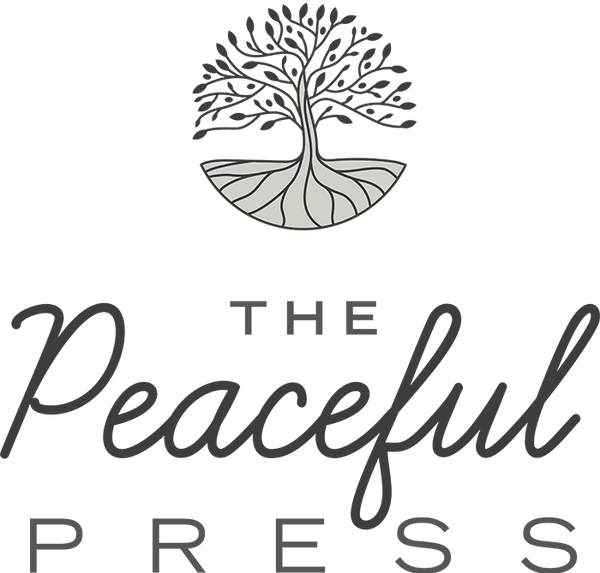Gentle Ways to Teach Your Child the Alphabet
Teaching the alphabet isn’t just about reciting ABCs—it’s about nurturing a lasting love for language through meaningful, sensory-rich experiences.
At The Peaceful Press, we take a literature and phonics centered approach to early literacy, combining intentional activities with beautifully curated resources to gently guide your preschool and kindergarten students into reading and writing.

1. Begin with Letters That Matter to Your Child
Start with the letters in your child’s name to spark interest and connection. When learning feels personal, it becomes memorable. In our Peaceful Preschool Volume 1, we introduce the alphabet in a relaxed, developmentally appropriate way, gently weaving letter recognition into each week’s rhythm.
2. Focus on Letter Sounds—and Names
Children need to know both what letters look like and the sounds they make. Teaching the sound of each letter (for example, saying “A says /a/ as in “ah”) helps phonemic awareness, a vital foundation for reading. Songs can help you remember letter names (think the classic ABC song, and this song by Barbara Milne is awesome for reinforcing letter sounds.
Each week in the Peaceful Preschool and Nourishing Nature Kindergarten we emphasize learning letter sounds through tracing textured letter flash cards, matching objects to initial letter sounds, and other engaging hands on phonics work.
3. Use Enjoyable Picture Books for Each Letter
In Peaceful Preschool, picture books are a cornerstone for letter learning. We recommend books like So Many Bunnies (cute and simple), B Is for Buckaroo (playful cowboy theme), and An Alphabet in Bloom (visually rich and minimal). Each offers an opportunity to highlight the letter of the week in an inviting way. Find a free list of alphabet books here.
4. Incorporate Hands-On Letter Formation
Before children use pencils, it’s helpful to explore letters through tactile methods so that motor skills are developed before children are expected to write:
- Tracing letters in salt trays
- Making letter shapes with glitter glue
- Forming letters with natural materials like sticks, leaves, or playdough
- Matching initial letter sounds to pictures
These sensory-stimulating activities are built into our curriculum to support multidimensional learning.

5. Let Letters Live in Your Environment
Once your child starts recognizing letters, let them point out those letters in the world around them—on cereal boxes, street signs, or art prints. This approach implements the “alphabet in motion” concept and connects abstract letter forms to real-world meaning.
Weekly Letter Lesson Flow
Here’s a gentle rhythm you can follow using Peaceful Preschool:
| Step | Activity | Goal |
|---|---|---|
| 1 | Read aloud and identify the featured letter | Foster listening and letter familiarity |
| 2 | Say the letter sound (“A says /a/”) | Develop phonemic awareness |
| 3 | Use the picture from the book to reinforce sound | Build connection between sound and meaning |
| 4 | Hands-on formation (salt tray, playdough, textured flash card tracing) | Strengthen letter sense through touch |
| 5 | Point out the letter in your surroundings | Apply learning to real-life contexts |
Why This Works
- Aligned with Emergent Literacy: Strong letter-name knowledge supports future reading success.
- Engages Multiple Senses: Oral language, visuals, tactile art, and environmental print all reinforce learning pathways.
- Flexible & Stress-Free: Four-day-a-week lessons leave room for rest, nature play, and family connection.

Engaging Motor Skills
The Peaceful Press doesn't just focus on learning the alphabet in our early years resources.
We also incorporate valuable large and fine motor skills that equip young children with a strong grip that helps them transition to holding a pencil and writing, as well as activities that build visual coordination and tracking.
Some of these activities include-
- Lacing Cards
- Squeezing glue or glitter glue
- Pouring
- Using clothespins
- Playing with clay
- Swinging at a ball
- Walking on a beam
- Pulling a wagon
- Playing with small nature items
- Arranging collage
- Playing eye spy
These large and fine motor skills might feel like play, but they are foundational to academic ability.
The most important thing to remember is to keep the pressure off.
In the Peaceful Press early years resources we include a variety of learning activities aimed at teaching early phonics and counting skills, but more importantly developing strong attachment between parents and strong motor skills.
Children all learn to read at different rates, so if alphabet learning isn't clicking for your child, try doing more motor skills or attachment work until they are ready.
Ready to get started with our delightful early learning resources?
Start with Peaceful Preschool Volume 1 for gentle alphabet and counting lessons.
For children who are ready for letter review you can transition to Peaceful Preschool Volume 2 or Nourishing Nature Kindergarten
Download a free sample of our engaging homeschool curriculum here

